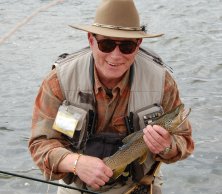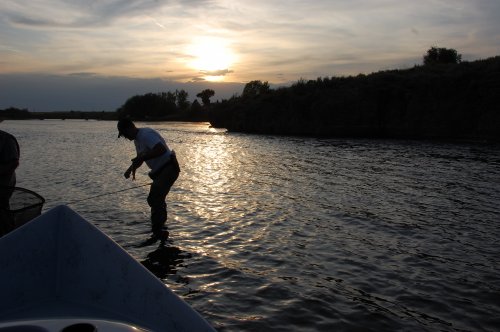The flats that I am speaking of are on the South Fork of the Snake River, Idaho.
When fly fishermen speak of fishing the flats, they feel the hot sun on their faces with the smell of a warm salt air breeze in their nose and the anticipation of hooking a high-powered bone fish. The flats that I am speaking of are on the South Fork of the Snake River, Idaho. This is where I enjoy fly fishing for the keen, strong-willed, self-disciplined, radiant colored wild trout.
The South Fork was the host to the 1997 World Fly-Fishing Championship. The South Fork is one of the best tailwater fisheries in the country. It is one of the most wild and scenic rivers I have ever fished. From the beginning at Palisades Dam, to the confluence with the Henry’s Fork, it is 66 miles long. The geological lay of the land that the river flows through gives a diversity of water that any fly fisherman will find to be a challenge. The South Fork houses 4 - 7 thousand trout per mile that will test your skills. This river is large and very intimidating. I had help in learning and fishing the South Fork from friends and neighbors like, LaMoyne & Mat Hyde of Hyde Drift Boats & Fly Shop, Tom Salas and Max Radford. When your intimidated by big water, talk to the fly shops and the local people.
The hatches of the South Fork are many: BWO’s, Salmon Flies, Golden Stones, Yellow Sallies, W. Green Drakes, PMD’s, Caddis, Gray Drakes, Mahogany Duns, Midges, Tricos and Terrestrials. I enjoy fly fishing for trout and will use what ever imitation it takes to outwit a trout. My true passions for catching trout is using the dry fly and the European methods of nymphing. The Flats of the South Fork will test your skills using either one of these techniques. These flats have riffled water with a gravel, cobble stone bottom. They will average about knee deep. At this depth, the sun will penetrate and warm the bottom, starting insect activity. With my experience, I found that the flats with the clean stone bottoms are the best to fish. Out of all these hatches, the one that intrigues me the most, are the PMD’s. The sizes of this fly are 18 - 16, which makes a lot of the rises difficult to see in the riffled water. This type of water will test your casting skills, and believe me these trout can be super selective. The South Fork is filled with aquatic insect live. Many trout will move onto these flats to feed, with some of them being very large. Hooking a size 18in trout on a size 16 or smaller PMD, and with the current of the S.F. you will be challenged in bringing these wild trout to the net. This is fly fishing at it’s finest.
I designed two flies to fish the PMD hatch on the South Fork. The first one I just call ( South Fork PMD ). This fly maybe fished as an emerger in the meniscus or as a wet fly under the meniscus. The second fly is a dry fly and rides on top of the meniscus imitating the dun stage. I call this one ( The Red-Headed Pinkster ) The hackle is put on using the method that Vincent C. Marinaro used on his thorax fly. I studied this method of crossing the hackles by using my slant tank with moving water and found that it gives a better impression on the meniscus then the standard catskill method of applying hackle. Both of these flies have out-witted numerous trout on the South Fork of the Snake River.
When there is no activity of PMD’s on the flats, do not drift over them. Beach the boat and rig for nymphing. This is where the third fly I designed comes into play. The flats have a very strong population of Salmon Fly nymphs ( Pteronarcys californica ). Last year, in mid September, 2011 my son Michael and I were casting to trout that were feeding on a good PMD hatch and having some classic dry fly fishing. We decided to brake for lunch and set down in the drift boat to eat. While eating, Michael and I took notice to Salmon Fly nymphs crawling on the bottom of the boat. I said to Michael that the nymphs must have been clinging to our wadding shoes when we got in the boat. We gathered the nymphs and put them back in the water. After we finished lunch, we had to start drifting to make the boat ramp before dark. Michael and I could not fish the next day, Friday but we went Saturday. Friday night the weather changed and Saturday was cloudy and cold. Before leaving home, I rigged my 4 weight rod to fish my SF PMD emerger and rigged my 5 weight to Czech nymph with an experimental Salmon Fly nymph that I designed, and named the Grunt. We put the drift boat in at Cottonwood and started our drift. The river was pretty quiet. We saw a moose along the way with bald eagles gliding low in the sky. We arrived at the first flat and saw no PMD activity. My son said," Dad this flat has a real dirty bottom" , so we kept drifting. We came to the next flat in short time and this one had a clean bottom. I beached the boat and anchored on the bank. Michael and I set in the boat drinking coffee and watching the riffles of the flat. Some PMD’s started to hatch but their numbers were not strong enough to start trout feeding. I decided to start nymphing with the Salmon Fly nymph that I designed. I began at the lower end of the flat, working up stream. On my second drift, I hooked a strong brown trout. My son wadded down and netted the brown, he was a little over 16in. Before my son got back to the boat, I had another trout hooked. He ask if he should come back and net the trout. I said no, finish rigging and start fishing. We caught trout after trout till the clock was working against us and we had to start drifting. My experimental Salmon Fly nymph work very well. The Grunt as I call it, has a woven abdomen and rubber legs, it is an impression of the Salmon Fly nymph that trout can not resist. By dinner time, the clouds broke and the sun came out. The water of the flats began to warm and the PMD’s came off in numbers. The trout went on a feeding frenzy. They were not selective to any one stage of hatching. Michael and I decided to use a two fly set-up. We tied the Red-Headed-Pinkster to the end of the tippet and used the SF PMD as the trailer. When my trailing fly is an emerger I use a duncan loop knot to fasten the fly to the trailing tippet. I do not tighten the loop because I want the fly to show as much live like movement as possible. It is a method that works very well. In this riffled water the trailing fly had to be on a short length of tippet. In a two fly set-up you do not want one fly in a different current seam then the other, or you will have instant drag. The trout were not selective with these two flies, they would rise to the emerger and the dry. We were catching so many trout that we lost track of time and did not arrive at the take out ramp until dark. My son and I had a tremendous day on the water.




















